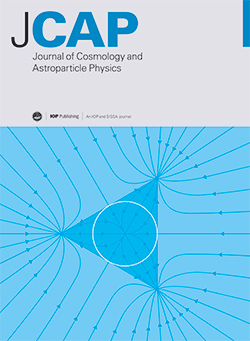Impact of large-scale structure systematics on cosmological parameter estimation
IF 5.9
2区 物理与天体物理
Q1 ASTRONOMY & ASTROPHYSICS
Journal of Cosmology and Astroparticle Physics
Pub Date : 2025-03-26
DOI:10.1088/1475-7516/2025/03/064
引用次数: 0
Abstract
Large near-future galaxy surveys offer sufficient statistical power to make our cosmology analyses data-driven, limited primarily by systematic errors. Understanding the impact of systematics is therefore critical. We perform an end-to-end analysis to investigate the impact of some of the systematics that affect large-scale structure studies by doing an inference analysis using simulated density maps with various systematics; these include systematics caused by photometric redshifts (photo-zs), Galactic dust, structure induced by the telescope observing strategy and observing conditions, and incomplete covariance matrices. Specifically, we consider the impacts of incorrect photo-z distributions (photometric biases, scatter, outliers; spectroscopic calibration biases), dust map resolution, incorrect dust law, selecting none or only some contaminant templates for deprojection, and using a diagonal covariance matrix instead of a full one. We quantify the biases induced by these systematics on cosmological parameter estimation using tomographic galaxy angular power spectra, with a focus on identifying whether the maximum plausible level of each systematic has an adverse impact on the estimation of key cosmological parameters from a galaxy clustering analysis with Rubin Observatory Legacy Survey of Space and Time (LSST). We find photo-z systematics to be the most pressing out of the systematics investigated, with spectroscopic calibration biases leading to the greatest adverse impact while helpfully being flagged by a high χ2 value for the best fit model. Larger-than-expected photo-z scatter, on the other hand, has a significant impact without necessarily indicating a poor fit. In contrast, in the analysis framework used in this work, biases from observational systematics and incomplete covariance matrices are comfortably subdominant.大尺度结构系统学对宇宙学参数估计的影响
近未来的大型星系调查提供了足够的统计能力,使我们的宇宙学分析受到数据驱动,主要受到系统误差的限制。因此,理解分类学的影响是至关重要的。我们执行端到端分析,通过使用各种系统的模拟密度图进行推理分析,调查影响大规模结构研究的一些系统的影响;其中包括光度红移(photo-zs)、星系尘埃、望远镜观测策略和观测条件引起的结构以及不完全协方差矩阵。具体来说,我们考虑了不正确的光-z分布(光度偏差、散射、异常值;光谱校准偏差),粉尘图分辨率,不正确的粉尘定律,选择没有或只有一些污染物模板进行去投影,并使用对角协方差矩阵而不是完整的协方差矩阵。我们利用层析星系角功率谱量化了这些系统对宇宙学参数估计的偏差,重点是确定每个系统的最大合理水平是否对鲁宾天文台时空遗留调查(LSST)的星系聚类分析中关键宇宙学参数的估计产生不利影响。我们发现photoz系统学是所调查的系统学中最紧迫的,光谱校准偏差导致最大的不利影响,同时通过高χ2值标记最佳拟合模型。另一方面,大于预期的photo-z散射会产生重大影响,但不一定表明拟合不良。相反,在这项工作中使用的分析框架中,来自观察系统和不完全协方差矩阵的偏差是次要的。
本文章由计算机程序翻译,如有差异,请以英文原文为准。
求助全文
约1分钟内获得全文
求助全文
来源期刊

Journal of Cosmology and Astroparticle Physics
地学天文-天文与天体物理
CiteScore
10.20
自引率
23.40%
发文量
632
审稿时长
1 months
期刊介绍:
Journal of Cosmology and Astroparticle Physics (JCAP) encompasses theoretical, observational and experimental areas as well as computation and simulation. The journal covers the latest developments in the theory of all fundamental interactions and their cosmological implications (e.g. M-theory and cosmology, brane cosmology). JCAP''s coverage also includes topics such as formation, dynamics and clustering of galaxies, pre-galactic star formation, x-ray astronomy, radio astronomy, gravitational lensing, active galactic nuclei, intergalactic and interstellar matter.
 求助内容:
求助内容: 应助结果提醒方式:
应助结果提醒方式:


